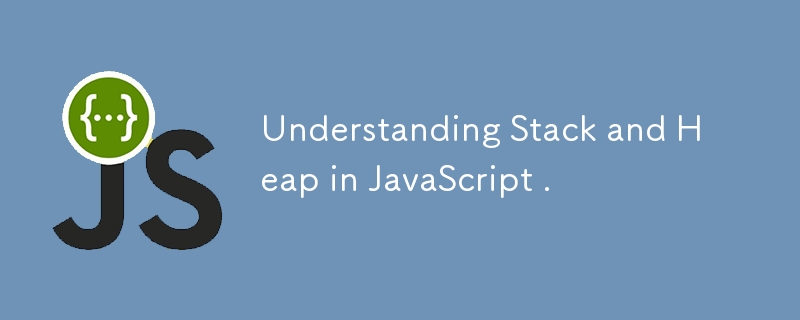了解 JavaScript 中的堆疊和堆疊。
發佈於2024-11-03

在 JavaScript 中,堆疊和堆是用於管理資料的兩種類型的內存,每種都有不同的用途:
- 堆
- 堆
*什麼是堆疊與堆*
堆疊:堆疊用於靜態記憶體分配,主要用於儲存基本類型和函數呼叫。它是一個簡單的後進先出 (LIFO) 結構,使其存取速度非常快。
Heap :堆用於動態記憶體分配,其中儲存物件和陣列(非基本類型)。與堆疊不同,堆更複雜且存取速度更慢,因為它允許靈活的記憶體分配。
堆疊記憶體範例:
let myName = "Amardeep"; //primitive type stored in stack let nickname = myName; // A copy of the value is created in the Stack nickname = "Rishu"; // Now changing the copy does not affect the original value . console.log(myName); // output => Amardeep (Original values remains unchanged since we are using stack) console.log(nickname); // output => rishu (only the copied value will changed)
在此範例中:
- myName 作為原始類型儲存在堆疊中。
- 當暱稱被指派 myName 的值時,會在 Stack 中建立該值的副本。
- 更改暱稱不會影響 myName ,因為它們在記憶體中是獨立的副本。
堆內存範例
現在讓我們檢查一下堆中如何管理非原始資料類型(物件)。
let userOne = { // The reference to this object is stored in the Stack.
email: "[email protected]",
upi: "user@ybl"
}; // The actual object data is stored in the Heap.
let userTwo = userOne; // userTwo references the same object in the Heap.
userTwo.email = "[email protected]"; // Modifying userTwo also affects userOne.
console.log(userOne.email); // Output: [email protected]
console.log(userTwo.email); // Output: [email protected]
在此範例中:
- userOne 保存對儲存在堆疊中的物件的參考。 -userTwo 被指派相同的引用,這表示 userOne 和 userTwo 都指向堆中的同一個物件。 -更改 userTwo.email 直接影響 userOne.email,因為兩個引用都指向記憶體中的相同位置。
要點
*堆疊記憶體*用於儲存原始類型和函數呼叫。每次分配一個值時,都會在堆疊中建立一個新副本。
*堆疊記憶體 *用於儲存物件和陣列。引用同一物件的變數共享記憶體中的相同記憶體位置,因此更改一個變數會影響其他變數。
版本聲明
本文轉載於:https://dev.to/amar_x_vr/understanding-stack-and-heap-in-javascript--11ho?1如有侵犯,請聯絡[email protected]刪除
最新教學
更多>
-
 如何在Ajax資料載入過程中顯示進度條?如何在Ajax 資料載入期間顯示進度條處理使用者觸發的事件(例如從下拉方塊中選擇值)時,通常會使用非同步擷取資料阿賈克斯。在獲取數據時,向用戶提供正在發生某事的視覺指示是有益的。本文探討了一種在 Ajax 請求期間顯示進度條的方法。 使用 Ajax 實作進度條要建立一個準確追蹤 Ajax 呼叫進度的...程式設計 發佈於2024-11-08
如何在Ajax資料載入過程中顯示進度條?如何在Ajax 資料載入期間顯示進度條處理使用者觸發的事件(例如從下拉方塊中選擇值)時,通常會使用非同步擷取資料阿賈克斯。在獲取數據時,向用戶提供正在發生某事的視覺指示是有益的。本文探討了一種在 Ajax 請求期間顯示進度條的方法。 使用 Ajax 實作進度條要建立一個準確追蹤 Ajax 呼叫進度的...程式設計 發佈於2024-11-08 -
 如何使用 CNTLM 存取工作場所代理程式後面的 pip?與CNTLM 的PIP 代理連接要使用CNTLM 訪問工作場所代理後面的pip,用戶可能會遇到--proxy 選項的問題。然而,利用環境變數提供了可靠的解決方案。 CNTLM 設定驗證可以透過執行「cntlm.exe -c cntlm.ini -I -M http://google.com」來實現。...程式設計 發佈於2024-11-08
如何使用 CNTLM 存取工作場所代理程式後面的 pip?與CNTLM 的PIP 代理連接要使用CNTLM 訪問工作場所代理後面的pip,用戶可能會遇到--proxy 選項的問題。然而,利用環境變數提供了可靠的解決方案。 CNTLM 設定驗證可以透過執行「cntlm.exe -c cntlm.ini -I -M http://google.com」來實現。...程式設計 發佈於2024-11-08 -
 如何使用 MySQL 資料庫中的時間序列資料填入 JFreechart TimeSeriesCollection?從 MySQL DB 填入 JFreechart TimeSeriesCollection此問題旨在使用 JFreechart TimeSeriesCollection 顯示一個月中幾天的溫度變化。然而,最初的實作面臨著從資料庫中準確讀取資料的挑戰。 時序資料的精確讀取要解決資料讀取問題,需要考慮之...程式設計 發佈於2024-11-08
如何使用 MySQL 資料庫中的時間序列資料填入 JFreechart TimeSeriesCollection?從 MySQL DB 填入 JFreechart TimeSeriesCollection此問題旨在使用 JFreechart TimeSeriesCollection 顯示一個月中幾天的溫度變化。然而,最初的實作面臨著從資料庫中準確讀取資料的挑戰。 時序資料的精確讀取要解決資料讀取問題,需要考慮之...程式設計 發佈於2024-11-08 -
 ValueError:無法將 NumPy 陣列轉換為張量 - 已解決?ValueError: Failed to Convert NumPy Array to Tensor問題描述嘗試使用TensorFlow 訓練具有LSTM 層的神經網路時,出現下列情況發生錯誤:ValueError: Failed to convert a NumPy array to a Ten...程式設計 發佈於2024-11-08
ValueError:無法將 NumPy 陣列轉換為張量 - 已解決?ValueError: Failed to Convert NumPy Array to Tensor問題描述嘗試使用TensorFlow 訓練具有LSTM 層的神經網路時,出現下列情況發生錯誤:ValueError: Failed to convert a NumPy array to a Ten...程式設計 發佈於2024-11-08 -
 為什麼Java重載不能基於回傳類型?Java 中的回傳型別重載:不相容儘管Java 具有多方面的功能,但該語言在重載函數時還是存在限制僅透過變更返回類型。這就提出了一個常見的問題:為什麼 Java 會禁止這樣的重載? 答案在於重載的基本性質。重載允許多個具有相同名稱的函數共存於一個類別中,並透過它們的參數簽名進行區分。然而,當返回類型...程式設計 發佈於2024-11-08
為什麼Java重載不能基於回傳類型?Java 中的回傳型別重載:不相容儘管Java 具有多方面的功能,但該語言在重載函數時還是存在限制僅透過變更返回類型。這就提出了一個常見的問題:為什麼 Java 會禁止這樣的重載? 答案在於重載的基本性質。重載允許多個具有相同名稱的函數共存於一個類別中,並透過它們的參數簽名進行區分。然而,當返回類型...程式設計 發佈於2024-11-08 -
 Angular 和 15 的改進1) 在沒有建構子的情況下在 Angular 14 中使用注入註入服務。 以前,注入任何服務總是需要具有建構函數的類別: class MyClass { constructor(private myService: MyService) {} } 現在,我們可以在函數和類別中註入服務。我們只需...程式設計 發佈於2024-11-08
Angular 和 15 的改進1) 在沒有建構子的情況下在 Angular 14 中使用注入註入服務。 以前,注入任何服務總是需要具有建構函數的類別: class MyClass { constructor(private myService: MyService) {} } 現在,我們可以在函數和類別中註入服務。我們只需...程式設計 發佈於2024-11-08 -
 物件導向程式設計:掌握 DSA 的第一步Imagine you're walking through a bustling factory. You see different machines, each designed for a specific purpose, working together to create a fina...程式設計 發佈於2024-11-08
物件導向程式設計:掌握 DSA 的第一步Imagine you're walking through a bustling factory. You see different machines, each designed for a specific purpose, working together to create a fina...程式設計 發佈於2024-11-08 -
 如何修復 Android 中的“java.lang.String 類型的值無法轉換為 JSONObject”錯誤?排除「java.lang.String 類型的值\u003cbr\u003e 無法轉換為JSONObject」錯誤在您的Android 應用程式中,您遇到與JSON 解析相關的錯誤。具體來說,您會看到以下例外:org.json.JSONException: Value <br of type...程式設計 發佈於2024-11-08
如何修復 Android 中的“java.lang.String 類型的值無法轉換為 JSONObject”錯誤?排除「java.lang.String 類型的值\u003cbr\u003e 無法轉換為JSONObject」錯誤在您的Android 應用程式中,您遇到與JSON 解析相關的錯誤。具體來說,您會看到以下例外:org.json.JSONException: Value <br of type...程式設計 發佈於2024-11-08 -
 如何在 JavaScript 中強制硬刷新並防止快取問題?解決JavaScript 快取問題:使用JavaScript 清除快取部署新的JavaScript 程式碼時,看不到反映的最新更新是令人沮喪的。此問題通常是由於快取的瀏覽器回應而引起的。為了消除這個問題,我們可以利用 JavaScript 函數 window.location.reload(true...程式設計 發佈於2024-11-08
如何在 JavaScript 中強制硬刷新並防止快取問題?解決JavaScript 快取問題:使用JavaScript 清除快取部署新的JavaScript 程式碼時,看不到反映的最新更新是令人沮喪的。此問題通常是由於快取的瀏覽器回應而引起的。為了消除這個問題,我們可以利用 JavaScript 函數 window.location.reload(true...程式設計 發佈於2024-11-08 -
 如何在 Python 中使用 Inflect 將整數轉換為單字?在Python 中將整數轉換為單字在Python 中將數值轉換為對應的單字表示形式可能是一項令人費解的任務。本文探討了使用 inflect 套件的簡單解決方案。 困境:困境:該示例嘗試將歌曲“99 Bottles of Beer”打印在Wall”,用文字替換數值。然而,代碼目前顯示的是數字而不是它們...程式設計 發佈於2024-11-08
如何在 Python 中使用 Inflect 將整數轉換為單字?在Python 中將整數轉換為單字在Python 中將數值轉換為對應的單字表示形式可能是一項令人費解的任務。本文探討了使用 inflect 套件的簡單解決方案。 困境:困境:該示例嘗試將歌曲“99 Bottles of Beer”打印在Wall”,用文字替換數值。然而,代碼目前顯示的是數字而不是它們...程式設計 發佈於2024-11-08 -
 關閉回應正文真的可以在 Go HTTP 用戶端中實現連線重用嗎?Go HTTP 用戶端連線重複使用:常見誤解Go HTTP 用戶端預設設計為重複使用連接,提供高效率的網路使用率。然而,某些場景可能會導致對連接重用的誤解。 原始查詢:無限連接創建在給定的程式碼中,最初看起來無限數量的連接正在被創建。不過,這個問題可以透過在收到回應後關閉請求正文來解決。這使得傳輸能...程式設計 發佈於2024-11-08
關閉回應正文真的可以在 Go HTTP 用戶端中實現連線重用嗎?Go HTTP 用戶端連線重複使用:常見誤解Go HTTP 用戶端預設設計為重複使用連接,提供高效率的網路使用率。然而,某些場景可能會導致對連接重用的誤解。 原始查詢:無限連接創建在給定的程式碼中,最初看起來無限數量的連接正在被創建。不過,這個問題可以透過在收到回應後關閉請求正文來解決。這使得傳輸能...程式設計 發佈於2024-11-08 -
 如何動態重定向Python函數中的標準輸出與錯誤流?Python 中的上下文流重定向標準輸出和錯誤流(stdout 和stderr)的重定向在許多場景中證明是重定向在許多場景中證明是有用的。然而,當函數持有對這些流的內部引用時,傳統方法通常會出現不足。 需要動態解決方案傳統的重新導向技術,如 sys.stdout,永久重新導向流。當方法本質上在內部複...程式設計 發佈於2024-11-08
如何動態重定向Python函數中的標準輸出與錯誤流?Python 中的上下文流重定向標準輸出和錯誤流(stdout 和stderr)的重定向在許多場景中證明是重定向在許多場景中證明是有用的。然而,當函數持有對這些流的內部引用時,傳統方法通常會出現不足。 需要動態解決方案傳統的重新導向技術,如 sys.stdout,永久重新導向流。當方法本質上在內部複...程式設計 發佈於2024-11-08 -
 如何在 Java 中有效地計算檔案或資料夾的大小?在Java 中取得檔案或資料夾的大小檢索檔案或資料夾的大小是處理檔案時的常見任務在爪哇。以下是如何有效地做到這一點:取得檔案大小要取得檔案的大小,您可以使用java.io 上的length() 方法.文件對象。這將傳回檔案的長度(以位元組為單位),如果檔案不存在,則傳回 0。 java.io.Fil...程式設計 發佈於2024-11-08
如何在 Java 中有效地計算檔案或資料夾的大小?在Java 中取得檔案或資料夾的大小檢索檔案或資料夾的大小是處理檔案時的常見任務在爪哇。以下是如何有效地做到這一點:取得檔案大小要取得檔案的大小,您可以使用java.io 上的length() 方法.文件對象。這將傳回檔案的長度(以位元組為單位),如果檔案不存在,則傳回 0。 java.io.Fil...程式設計 發佈於2024-11-08
學習中文
- 1 走路用中文怎麼說? 走路中文發音,走路中文學習
- 2 坐飛機用中文怎麼說? 坐飞机中文發音,坐飞机中文學習
- 3 坐火車用中文怎麼說? 坐火车中文發音,坐火车中文學習
- 4 坐車用中文怎麼說? 坐车中文發音,坐车中文學習
- 5 開車用中文怎麼說? 开车中文發音,开车中文學習
- 6 游泳用中文怎麼說? 游泳中文發音,游泳中文學習
- 7 騎自行車用中文怎麼說? 骑自行车中文發音,骑自行车中文學習
- 8 你好用中文怎麼說? 你好中文發音,你好中文學習
- 9 謝謝用中文怎麼說? 谢谢中文發音,谢谢中文學習
- 10 How to say goodbye in Chinese? 再见Chinese pronunciation, 再见Chinese learning

























